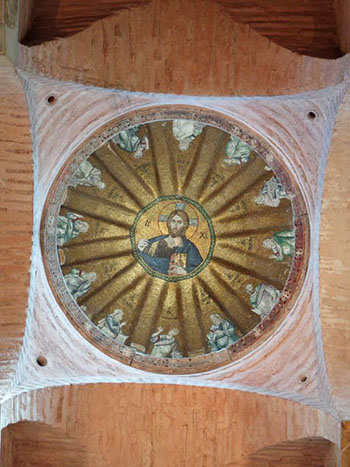
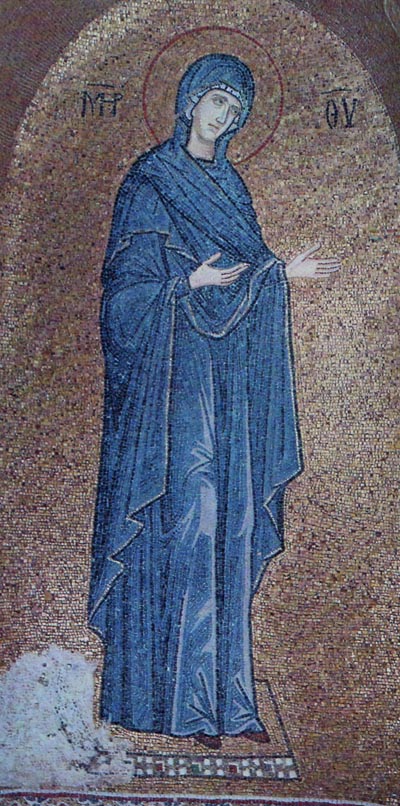
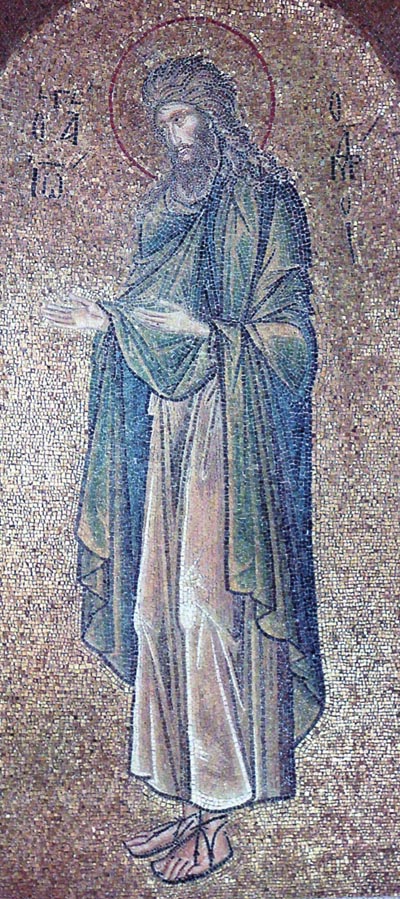
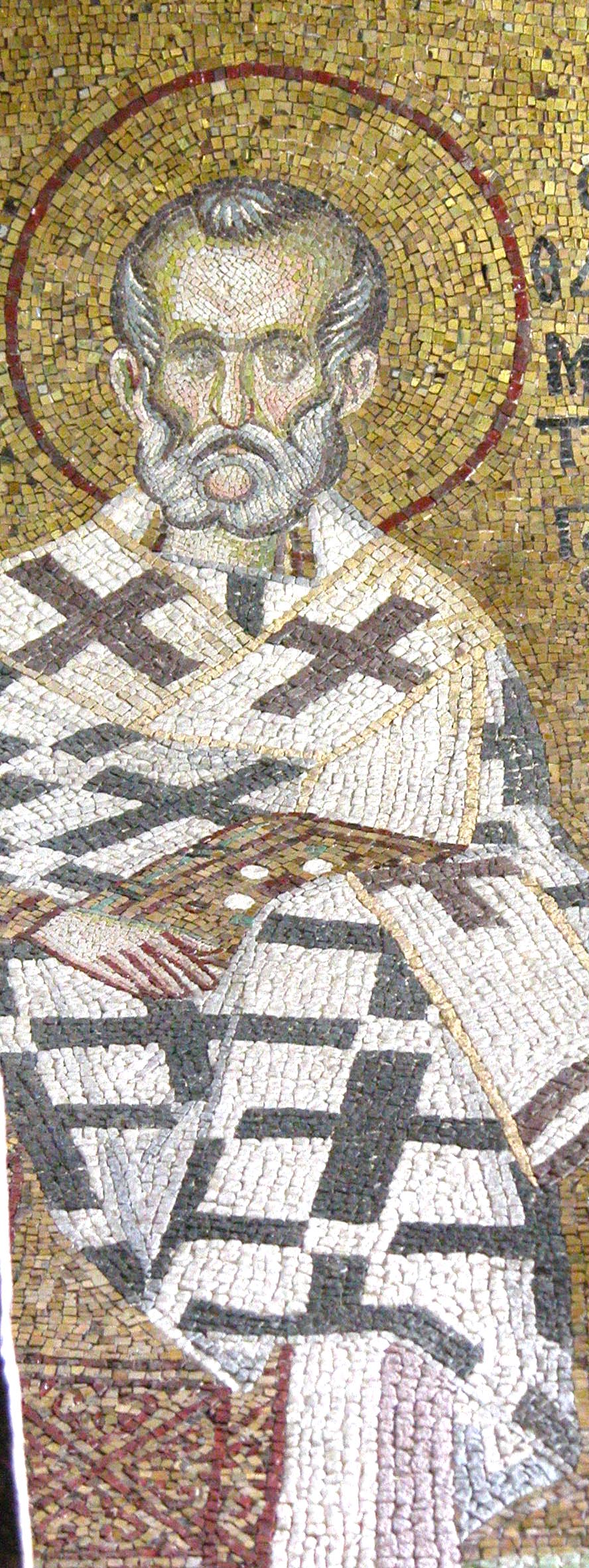
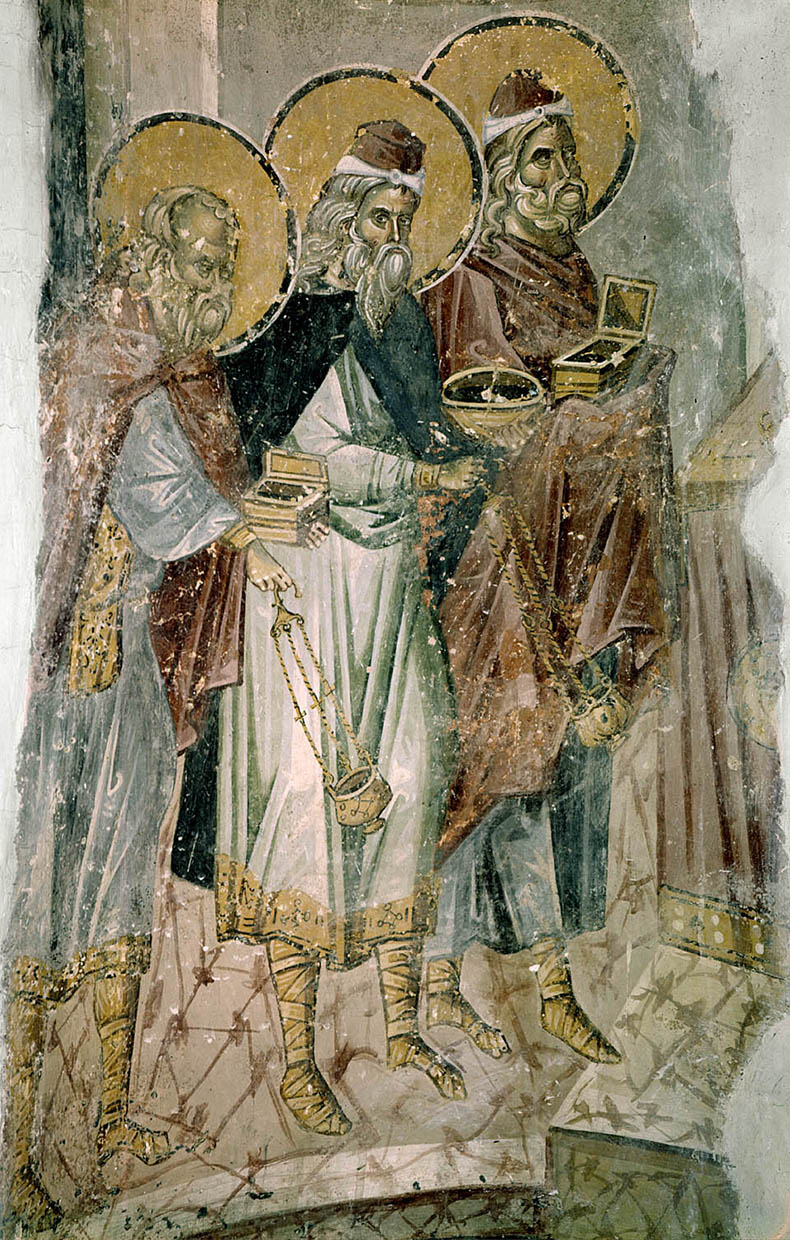
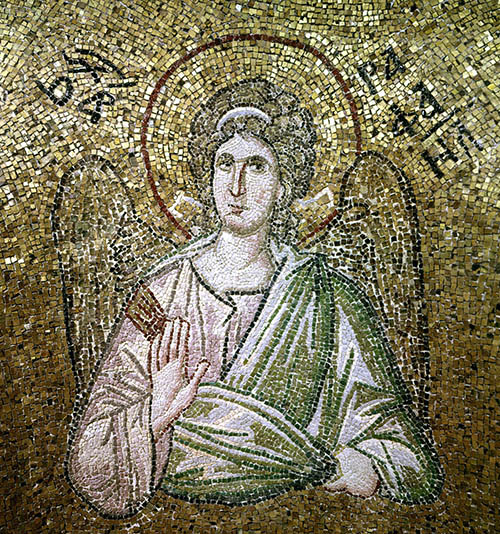
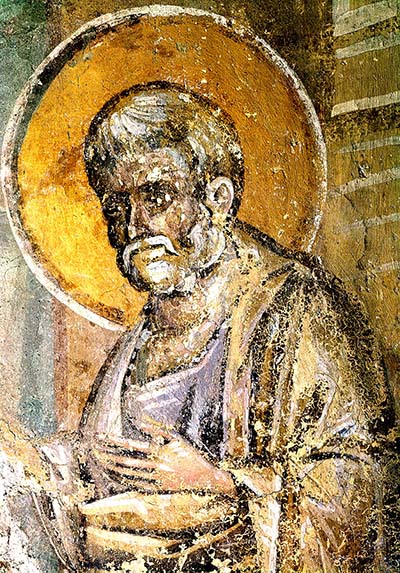

Christ Pantokrators of the Pammakaristos
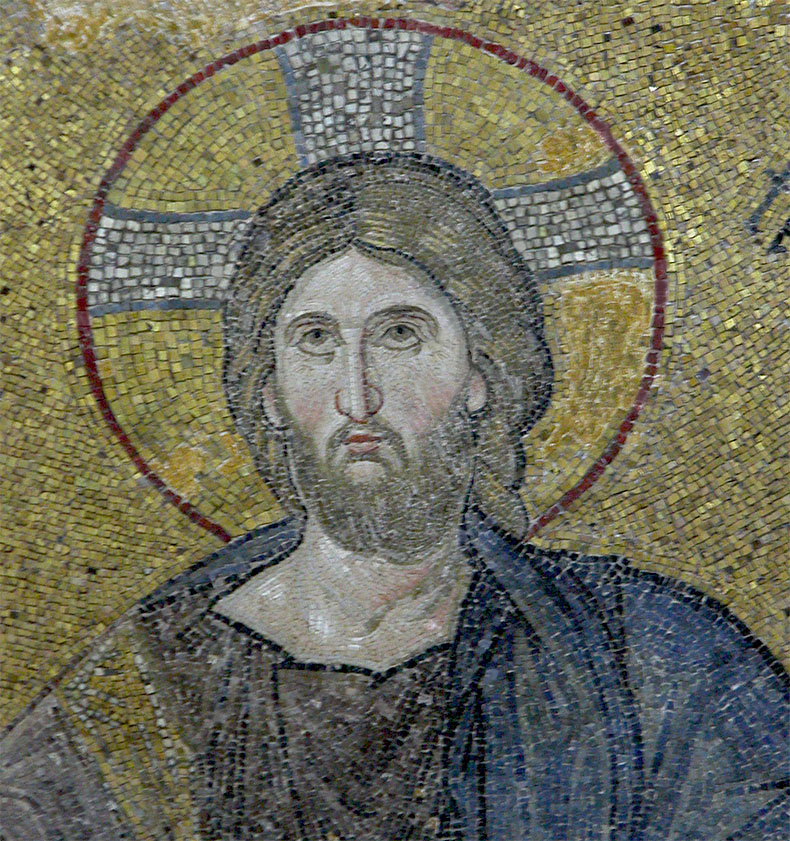
This life-sized image of Christ carries the inscription Hyperagathos - "Supremely Loving" - of humanity. Here Christ extends his hand outwards in blessing. Standing in the chapel and looking at the icon he appears that Christ's hand extends into the real space of the sanctuary above the viewer. Around the image of Christ is an inscription saying that the nun Martha offers this chapel in honor of her husband as a 'pledge of salvation". All of the mosaics of the chapel were the work of one artist. He would have had assistants to do the plastering and preparation for the laying of the mosaic. He would have done his own fresco painting prior to laying the mosaic cubes in the last layer of fine plaster.
It looks like the mosaic was done from salvage cubes taken from other ruined or abandoned churches, rather than ordered new from a glass factory. This can be sen in the irregular size and chipped corners of cubes, especially the gold mosaic of the background and the silver cubes in the halo.
Since one solo artist did the mosaic work and the fact that mosaic could only be laid from late spring to fall because the plaster needed to dry; the project might have taken several years to finish.
All work like this was done by contact, which laid out the overall plan of the mosaic program, where the supplies would come from and a timeline with a payment schedule. This artist could have been working as an individual or be on loan from a larger workshop. He might have been selected for the quality of his work that had been sen in another church, place or aristocratic mansion. This church was a part of a network of monasteries connected to the Imperial court and the military establishment that was clustered around the northwest corner of the city. It was near the Blachernae Palace and some of the most active commercial enterprises of the city including workshops, taverns and retail sales, especially foodstuffs. This church was on a bluff above the Golden Horn and had a great view of the city.
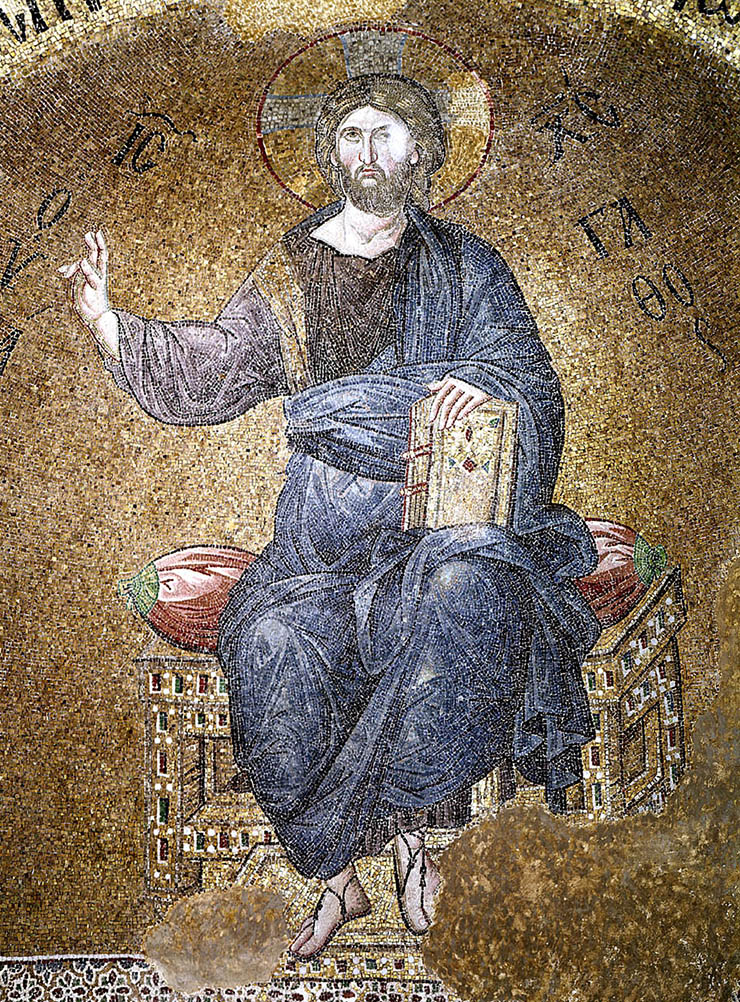 The chapel is interesting in that it has a mosaic of the Pantokrator in the apse and in the dome. Normally mosaics were done from the top down with the dome beginning done first. However, since this was a small project and one artist was laying the mosaic, the artist could have started with the apse - or anywhere. Again, because of the small size of the chapel the scaffolding would have been relatively easy to move around. Before the artist started work all of the marble revetment - including a wonderful inlaid champleve border of lions - would have been done. There is an inscription going all the way around the chapel and this would have been done last. The artist who did the mosaics may have painted this inscription, too.
The chapel is interesting in that it has a mosaic of the Pantokrator in the apse and in the dome. Normally mosaics were done from the top down with the dome beginning done first. However, since this was a small project and one artist was laying the mosaic, the artist could have started with the apse - or anywhere. Again, because of the small size of the chapel the scaffolding would have been relatively easy to move around. Before the artist started work all of the marble revetment - including a wonderful inlaid champleve border of lions - would have been done. There is an inscription going all the way around the chapel and this would have been done last. The artist who did the mosaics may have painted this inscription, too.
The mosaic of the Pantokrator is of both Christ blessing and saving, which would have been appropriate to a burial chapel.
A parekklesion - built in the cross-in-square technique - was added to the church by the Maria Brana Doukaina Palaeologina to the right side of the church in honor of her husband Michael Glabas Tarchaneiotes in the early fourteenth century. He lived from around 1325 and died around 1310. Michael took over responsibility for the monastery in 1263, just two years after the retaking of the city by Michael VII Palaeologius in 1261. The man he appointed to run the monastery, a monk named Cosmas, was elected Patriarch less than a year later, in 1294. Michael had obtained one of the highest of court ranks, that of Protostrator. He definitely had died by I315, when another man, John Philes Palaeologus, was appointed Protostrator.
Michael also had a special devotion to St. Euthymios, whose chapel he restored and painted next to St. Demetrios in Thessaloniki. Michael probably became a monk in his last days, having suddenly left military service due to illness. After her husband's death Maria took the veil and became a nun, taking the name of Martha. She did not enter religious life at the Pammakaristos, which was a men's monastery, but at the Convent of the Virgin of the Sure Hope where her sister also took holy orders later. Michael's tomb was placed in the an arcosolium in the north wall. Michael and Maria's tombs were swept away when the church of the Pammakaristos was taken from the church and converted into a Islamic victory mosque in the 16th century.
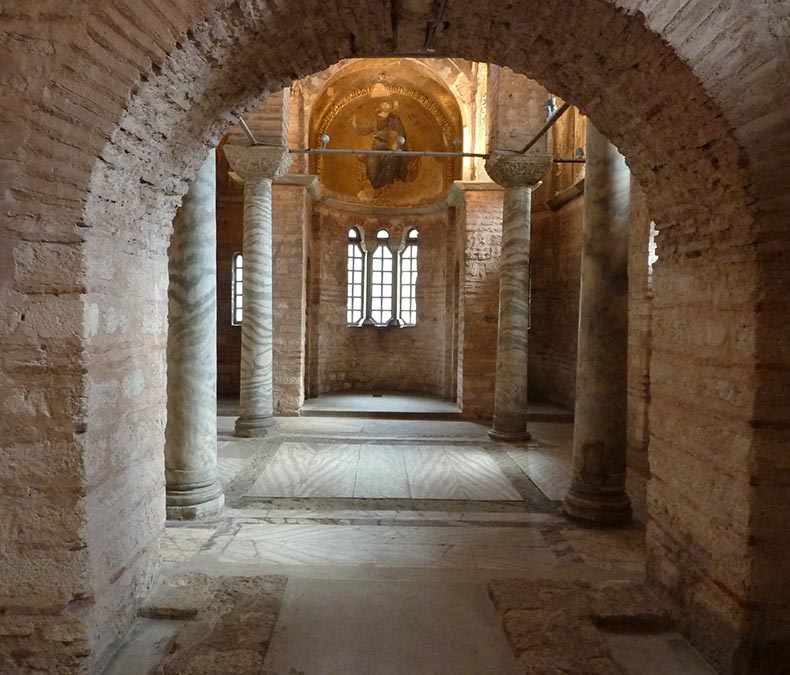
The chapel has elegant proportions. Combined with massive Proconnesian marble slabs, the chapel had inlaid Cosmatesque pavement borders, a fragment of which is preserved in the northeast corner. Fragments of the carved fourteenth century marble templon - iconostasis - were found in the church, are now in the Hagia Sophia Museum. Fragments of a marble arch decorated with busts of saints was also been found here. This may have come from the tomb of Michael Glabas.
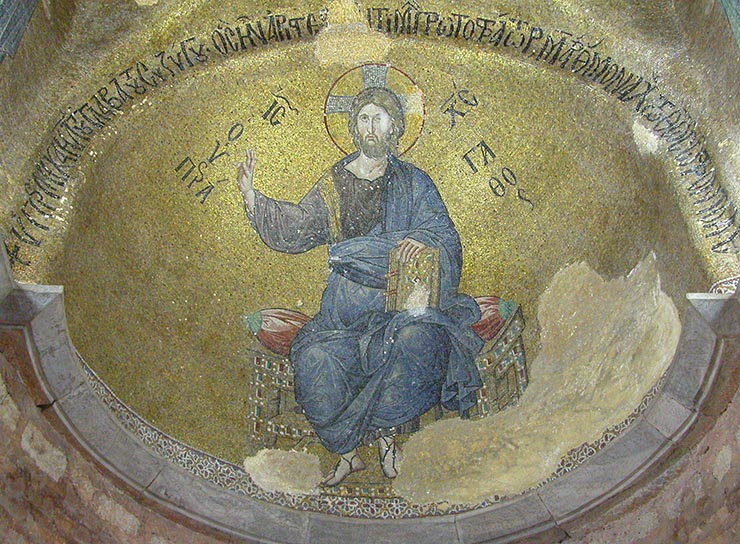 The tunic of Christ is made of blue-violet glass cubes, the himation is laid in four shades of ultramarine blue glass, both of which are beautifully drawn and modeled. Christ's throne has a lot of jeweled detail in in and it is set with red and green pillow, which is also amazing for it's detail and drawing. His arm and hand of blessing extend into the space of the apse in a forceful way. The figure is a remarkable image of Christ and should be better known to art historians.
The tunic of Christ is made of blue-violet glass cubes, the himation is laid in four shades of ultramarine blue glass, both of which are beautifully drawn and modeled. Christ's throne has a lot of jeweled detail in in and it is set with red and green pillow, which is also amazing for it's detail and drawing. His arm and hand of blessing extend into the space of the apse in a forceful way. The figure is a remarkable image of Christ and should be better known to art historians.
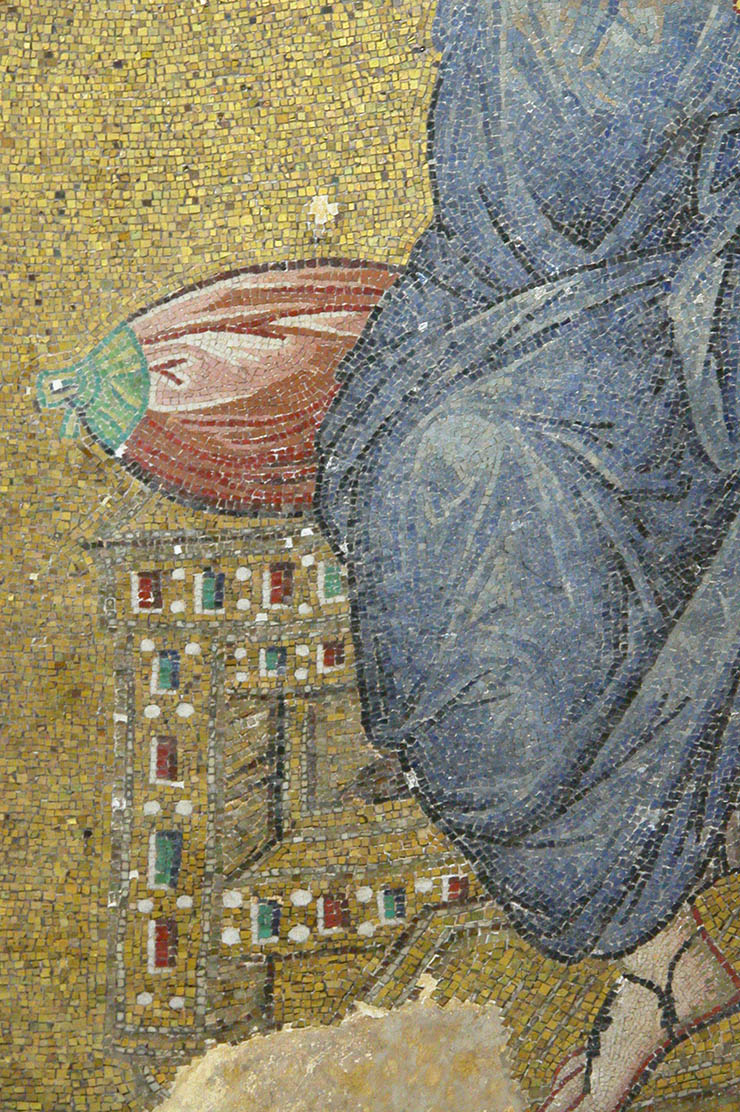
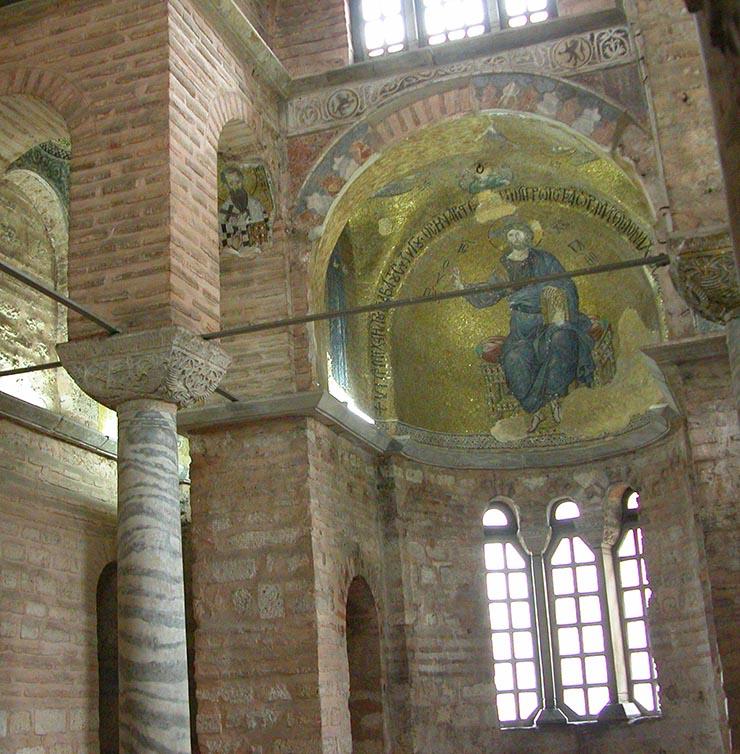 Some parts of the marble revetment of the chapel have survived and they are topped by a delightful marble frieze ornamented in the champleve technique, which circles the building. The frieze is inlaid with black pitch (which has faded to a dull blue-gray in most places) and a red substance. It shows vines, round medallions and heart-shaped shields containing rampant red lions and other fanciful animals including paired birds. It is thought the lions are a family crest associated with the Glabas family.
Some parts of the marble revetment of the chapel have survived and they are topped by a delightful marble frieze ornamented in the champleve technique, which circles the building. The frieze is inlaid with black pitch (which has faded to a dull blue-gray in most places) and a red substance. It shows vines, round medallions and heart-shaped shields containing rampant red lions and other fanciful animals including paired birds. It is thought the lions are a family crest associated with the Glabas family.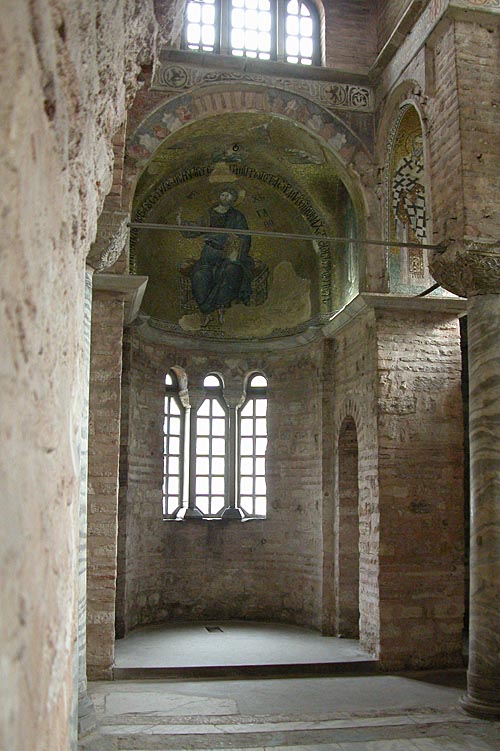
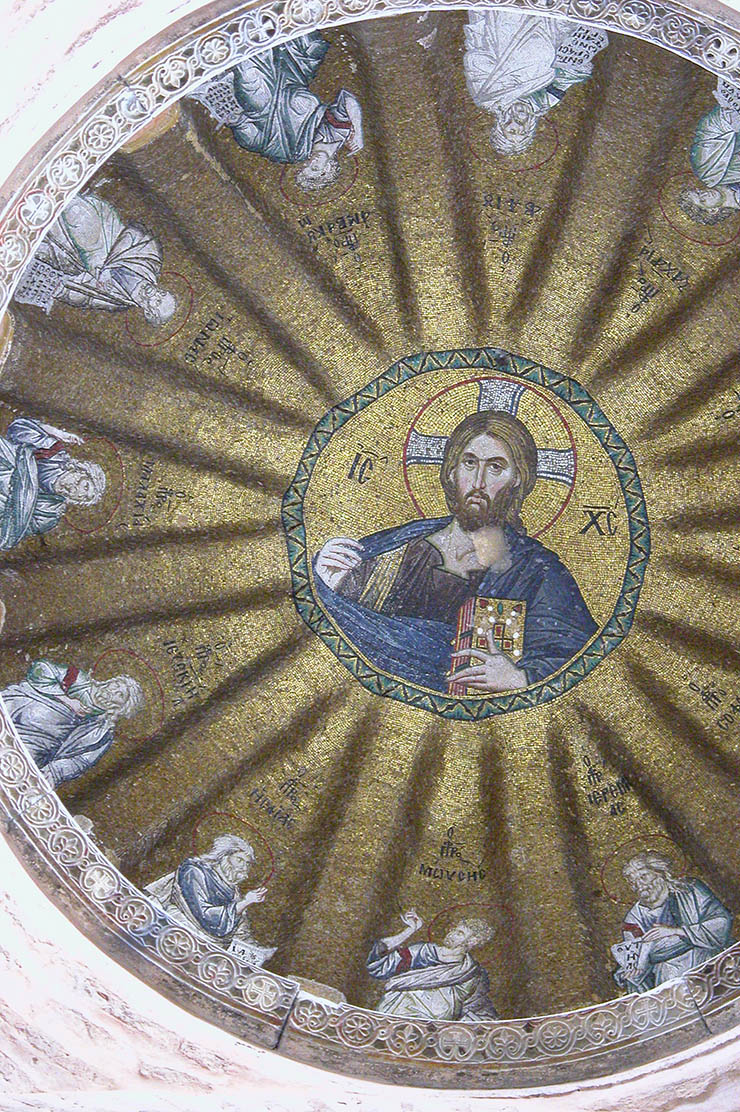 There is a difference in style between the Christ Pantokrator in the dome and His image in the apse. They are based on different prototypes. The Pantokrator in the dome is more conventional because the artist had made many of these before. The marble cornice of the dome is carved with crosses and rosettes. It was painted blue and the raised carving was covered with red bole and gilded. The crosses were left white.
There is a difference in style between the Christ Pantokrator in the dome and His image in the apse. They are based on different prototypes. The Pantokrator in the dome is more conventional because the artist had made many of these before. The marble cornice of the dome is carved with crosses and rosettes. It was painted blue and the raised carving was covered with red bole and gilded. The crosses were left white.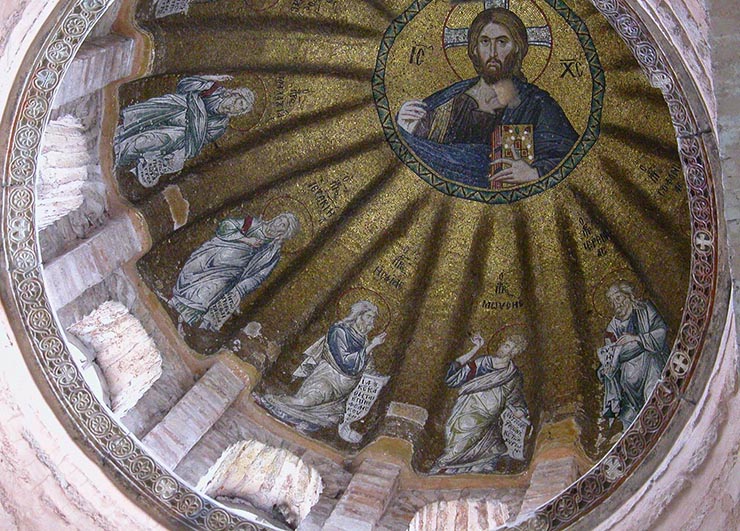
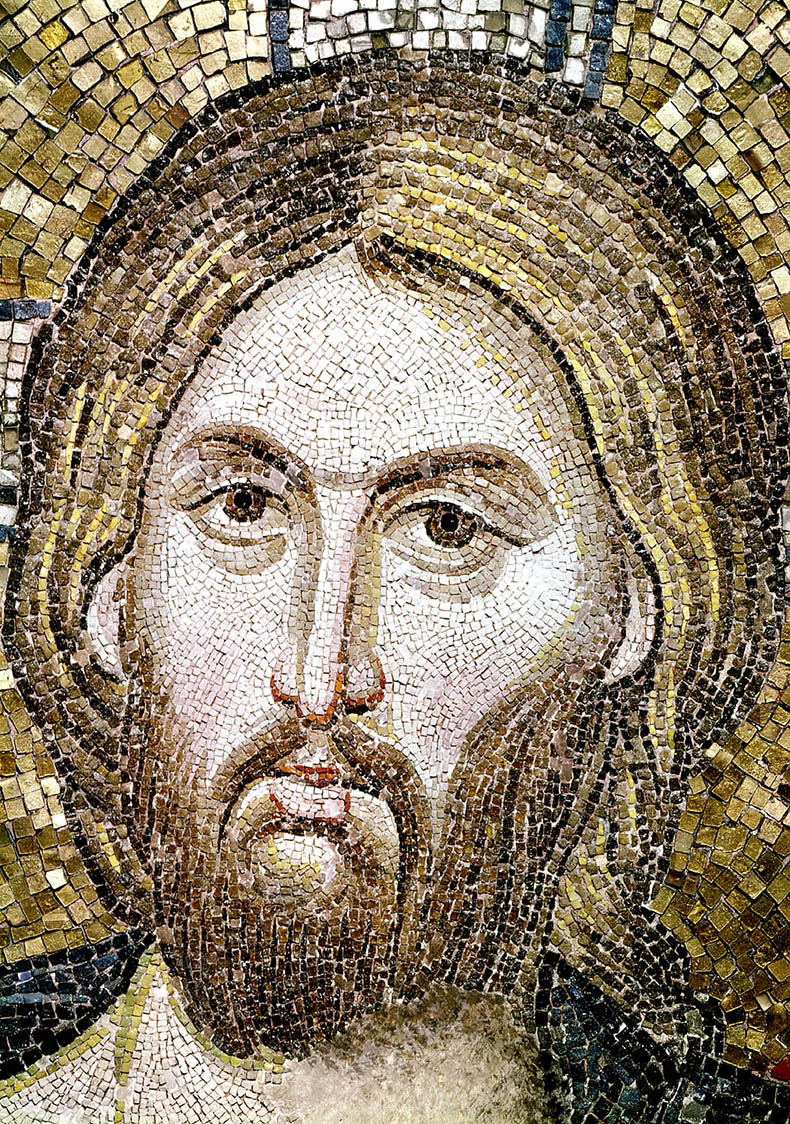

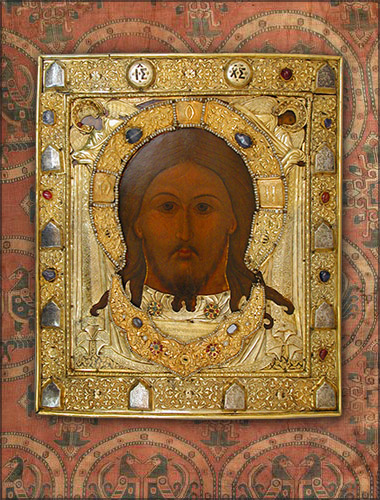


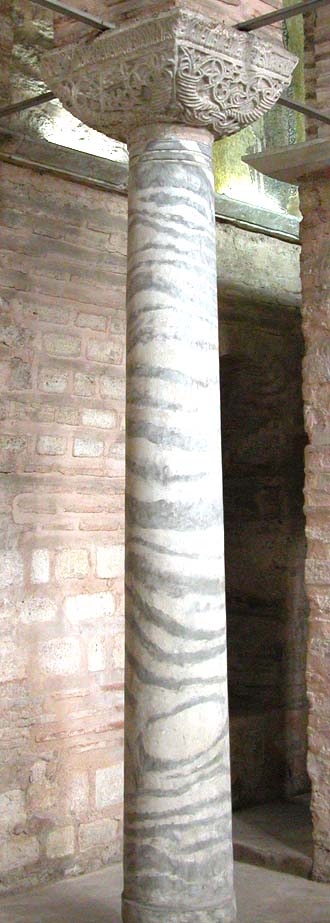
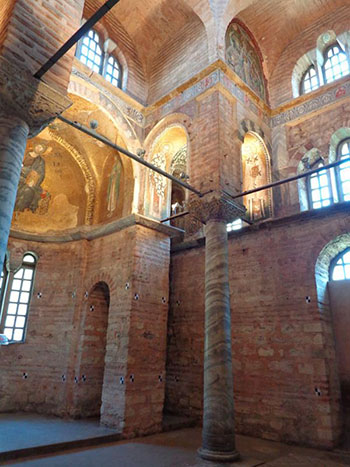
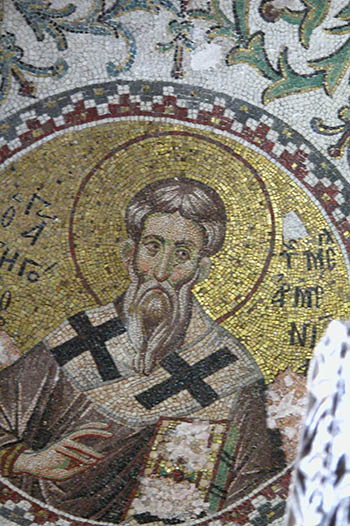
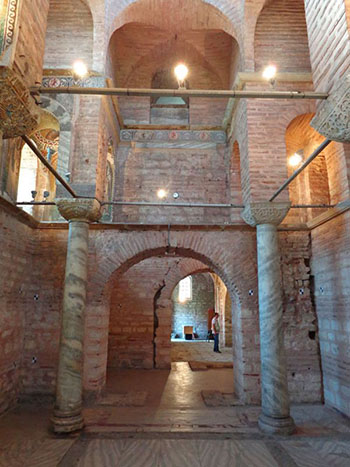
 click here for icons of christ
click here for icons of christ click here for icons of the theotokos
click here for icons of the theotokos click here for icons of angels
click here for icons of angels click here for icons of saints
click here for icons of saints








